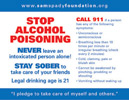We are currently rebuilding our online store. To order any of the items below please call us at 402.239.9674
| Poster | |
| Table Tents |  |
| T-Shirts | |
| SAM Wallet Cards |
We are currently rebuilding our online store. To order any of the items below please call us at 402.239.9674
| Poster | |
| Table Tents |  |
| T-Shirts | |
| SAM Wallet Cards |